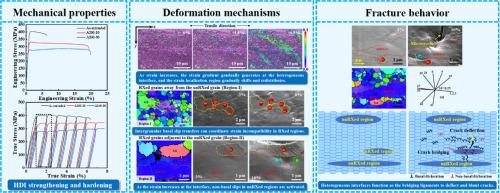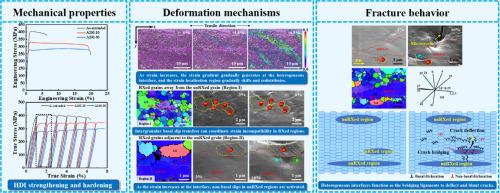Heterostructure control enabling outstanding strength-crack tolerance synergy in a dilute Mg-Al-Mn-Zn-Ce-Nd alloy
IF 13.8
1区 材料科学
Q1 METALLURGY & METALLURGICAL ENGINEERING
引用次数: 0
Abstract
There exists a severe strength-crack tolerance trade-off in dilute magnesium (Mg) alloys. Herein, a heterogeneous Mg-0.6Al-0.6Mn-0.5Zn-0.2Ce-0.2Nd (A200-10) alloy with a high density of dislocations was obtained through low-temperature extrusion and short-term annealing. The microstructure consists of recrystallized (RXed) and unrecrystallized (unRXed) regions, with a precisely controlled volume fraction ratio of 3:1. The heterogeneous A200-10 alloy exhibits a high tensile yield strength (TYS) of ∼306 MPa and a superior tensile elongation (TEL) of ∼18.4%. Based on quasi-in-situ electron backscattered diffraction (EBSD) and scanning electron microscope (SEM)-digital image correlation (DIC) analysis, we find that plastic deformation occurs preferentially in the RXed regions, mediated by the mobile <a> dislocations. As strain increases, strain gradient gradually accumulates at the interface between RXed and unRXed regions, generating hetero-deformation induced (HDI) strengthening and hardening. Besides, there is significant intergranular slip transfer in RXed regions, which can coordinate partial strain incompatibility. Furthermore, heterogeneous interfaces play a crucial role in enhancing crack tolerance. The heterogeneous interface functions as a bridging ligament to withstand stresses, and activates non-basal slips in the unRXed grains near the crack tip. Such activation of extra dislocations not only alleviates stress concentration but also dissipates the energy essential for microcrack propagation, thus effectively blunting the crack tip. Accordingly, the heterogeneous A200-10 alloy obtains an excellent strength and elongation combination. This work is anticipated to provide a valuable avenue for the development of Mg alloys with outstanding performance by regulating the appropriate heterostructure.


异质结构控制使稀Mg-Al-Mn-Zn-Ce-Nd合金具有优异的强度-裂纹容忍协同效应
稀镁合金存在严重的强度-裂纹容差。通过低温挤压和短期退火,得到了位错密度高的非均相mg -0.6 al -0.6 mn -0.5 zn -0.2 ce -0.2 (A200-10)合金。微观结构由再结晶区(RXed)和非再结晶区(unxed)组成,精确控制体积分数比为3:1。非均相A200-10合金的抗拉屈服强度(TYS)为~ 306 MPa,抗拉伸长率(TEL)为~ 18.4%。基于准原位电子背散射衍射(EBSD)和扫描电子显微镜(SEM)-数字图像相关(DIC)分析,我们发现塑性变形优先发生在RXed区域,由移动<;a>;混乱。随着应变的增加,在RXed和unxed区域的界面处逐渐积累应变梯度,产生异质变形诱导(HDI)强化和硬化。此外,RXed区域存在明显的晶间滑移传递,可以协调部分应变不相容。此外,非均质界面在提高裂纹容限方面起着至关重要的作用。非均质界面作为桥接韧带来承受应力,并激活裂缝尖端附近unxed晶粒的非基底滑移。这种额外位错的激活不仅减轻了应力集中,而且消散了微裂纹扩展所必需的能量,从而有效地钝化了裂纹尖端。因此,非均相A200-10合金获得了优异的强度和伸长率组合。本研究为通过调控适当的异质结构来开发性能优异的镁合金提供了一条有价值的途径。
本文章由计算机程序翻译,如有差异,请以英文原文为准。
求助全文
约1分钟内获得全文
求助全文
来源期刊

Journal of Magnesium and Alloys
Engineering-Mechanics of Materials
CiteScore
20.20
自引率
14.80%
发文量
52
审稿时长
59 days
期刊介绍:
The Journal of Magnesium and Alloys serves as a global platform for both theoretical and experimental studies in magnesium science and engineering. It welcomes submissions investigating various scientific and engineering factors impacting the metallurgy, processing, microstructure, properties, and applications of magnesium and alloys. The journal covers all aspects of magnesium and alloy research, including raw materials, alloy casting, extrusion and deformation, corrosion and surface treatment, joining and machining, simulation and modeling, microstructure evolution and mechanical properties, new alloy development, magnesium-based composites, bio-materials and energy materials, applications, and recycling.
 求助内容:
求助内容: 应助结果提醒方式:
应助结果提醒方式:


